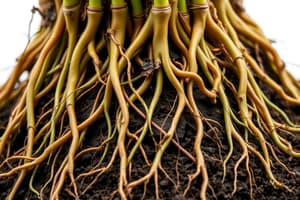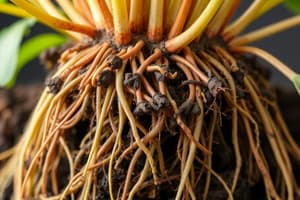Podcast
Questions and Answers
What is the primary function of the root cap?
What is the primary function of the root cap?
- To protect the vascular tissues
- To absorb water and minerals
- To protect delicate tissues and perceive gravity (correct)
- To allow cell division
What type of root system develops primarily in dicot plants?
What type of root system develops primarily in dicot plants?
- Adventitious root system
- Taproot system (correct)
- Surface root system
- Fibrous root system
Which region of the root is responsible for cell elongation?
Which region of the root is responsible for cell elongation?
- Region of differentiation
- Region of maturation
- Root cap
- Region of elongation (correct)
What specialized function do food-storage roots serve?
What specialized function do food-storage roots serve?
Which of the following best describes 'adventitious roots'?
Which of the following best describes 'adventitious roots'?
How does the region of cell division in the root contribute to root growth?
How does the region of cell division in the root contribute to root growth?
What is the primary role of root hairs in the root-hair zone?
What is the primary role of root hairs in the root-hair zone?
Which of the following statements is true regarding the regions of a developing root?
Which of the following statements is true regarding the regions of a developing root?
What is the primary function of axillary buds?
What is the primary function of axillary buds?
Which type of stem grows horizontally below ground and can produce adventitious roots?
Which type of stem grows horizontally below ground and can produce adventitious roots?
What distinguishes a bulb from a corm?
What distinguishes a bulb from a corm?
Which modified stem is known for growing above ground and is often referred to as a runner?
Which modified stem is known for growing above ground and is often referred to as a runner?
What features characterize a terminal bud?
What features characterize a terminal bud?
Which structure does the climbing plant English ivy utilize for support?
Which structure does the climbing plant English ivy utilize for support?
What are cladophylls primarily responsible for in plants like the butcher-broom?
What are cladophylls primarily responsible for in plants like the butcher-broom?
Which of the following statements best describes a winter bud?
Which of the following statements best describes a winter bud?
What is the primary function of pneumatophores in swamp plants?
What is the primary function of pneumatophores in swamp plants?
How do contractile roots benefit bulbs and corms?
How do contractile roots benefit bulbs and corms?
What role do buttress roots play in tropical trees?
What role do buttress roots play in tropical trees?
Which type of root is involved in both moisture absorption and moisture retention in orchids?
Which type of root is involved in both moisture absorption and moisture retention in orchids?
How do parasitic roots function in dodder plants?
How do parasitic roots function in dodder plants?
What type of roots develop from the branches of banyan trees?
What type of roots develop from the branches of banyan trees?
What is the function of root nodules found in peas and beans?
What is the function of root nodules found in peas and beans?
Which type of root primarily aids in climbing and growing support for plants like ivies?
Which type of root primarily aids in climbing and growing support for plants like ivies?
What is the basic structure of most mature leaves?
What is the basic structure of most mature leaves?
Which type of leaf structure has leaflets arranged in pairs along a central stalk?
Which type of leaf structure has leaflets arranged in pairs along a central stalk?
What process is primarily carried out by green leaves to capture light energy?
What process is primarily carried out by green leaves to capture light energy?
What is the purpose of transpiration in plants?
What is the purpose of transpiration in plants?
Which type of venation has a main vein with secondary veins branching from it?
Which type of venation has a main vein with secondary veins branching from it?
Which characteristic identifies bipinnately compound leaves?
Which characteristic identifies bipinnately compound leaves?
What modification do tendrils represent in some plant leaves?
What modification do tendrils represent in some plant leaves?
How are reproductive leaves characterized in air plants?
How are reproductive leaves characterized in air plants?
What are bracts in relation to flowers?
What are bracts in relation to flowers?
What is the primary function of storage leaves in desert plants?
What is the primary function of storage leaves in desert plants?
Which of the following statements correctly describes spines?
Which of the following statements correctly describes spines?
What distinguishes thorns from spines?
What distinguishes thorns from spines?
What are prickles in relation to other plant structures?
What are prickles in relation to other plant structures?
Flashcards are hidden until you start studying
Study Notes
Root Systems
- Taproot systems are found in dicots, and develop from the radicle.
- Fibrous Root systems are found in monocots, and develop from adventitious roots
- Adventitious refers to new, often unusual structures growing from a different part of the plant.
Root System Structure
- The root tip is protected by a thimble-shaped mass of parenchyma cells called the root cap.
- The root cap also helps the root sense gravity.
- The region of cell division is in the center of the root tip, surrounded by the root cap.
- This region is composed of an apical meristem.
- The region of elongation is where cells grow several times their original length.
- The region of maturation is where cells differentiate and mature into different types of cells.
Specialized Roots
- Food storage roots are enlarged roots that store starch and carbohydrates.
- Propagative roots can develop buds along the roots that turn into stems, called suckers.
- Pneumatophores are spongy roots found in swamp plants, protruding above the surface.
- They help facilitate gas exchange between the roots and the atmosphere.
- Aerial roots can be found in various plants, with different functions.
- Velamen roots in orchids have several cell layers, aiding in absorbing rainwater.
- Prop roots in corn grow from the stem base to support the plant.
- Prop roots in tropical figs and banyan trees grow from branches and eventually act as additional trunks.
- Adventitious roots in ivy help the plant climb.
- Photosynthetic roots are found in some orchids and corn, helping with photosynthesis.
- Contractile roots pull bulbs and corms deeper into the soil.
- Buttress roots are large, flat roots that provide stability for trees in shallow soil.
- Parasitic roots, found in plants like dodder, lack chlorophyll and depend on other plants for nutrients.
- Root nodules are swellings containing nitrogen-fixing bacteria, found in legumes like peas and beans.
Stems
- Each node of a stem usually contains an axillary bud, which can develop into a branch.
- Winter buds are protected by bud scales that fall off when growth begins.
- Terminal buds, found at the tips of twigs, extend the twig's length during the growing season.
- Stipules are appendages found at the base of the petiole, leaving scars when they fall off.
Specialized Stems
- Rhizomes are horizontal stems that grow below ground, producing adventitious roots.
- Stolons are horizontal stems that grow above ground, also called runners.
- Tubers are swollen stolons that store food, with nodes called "eyes."
- Bulbs are large buds with a small stem surrounded by fleshy leaves, storing food.
- Corms are similar to bulbs but consist mostly of stems, with a few papery leaves.
Stems Modified for Climbing
- Rambles are stems that simply rest on other plants.
- Tendrils are specialized stems in grapevines, or modified leaves or leaf parts in peas.
- Adventitious roots in English ivy aid in climbing.
Leaves
- Leaves develop from primordial structures in buds.
- Most leaves have a petiole (stalk) connecting a flattened blade (lamina) to the stem.
- Stipules, a pair of appendages, are sometimes found at the base of the petiole.
- Sessile leaves lack petioles and attach directly to the stem.
Leaf Functions
- Photosynthesis is the primary function of green leaves.
- Leaves also help with respiration and removal of waste products.
- Leaves transport water from roots throughout the plant.
- Transpiration is the process of water evaporation from leaves.
Types of Leaves
- Simple leaves have undivided blades.
- Compound leaves have blades divided into leaflets.
- Pinnately compound leaves have leaflets in pairs along a central stalk.
- Palmately compound leaves have leaflets attached at the same point.
- Bipinnately compound leaves have leaflets that are further subdivided.
Leaf Venation
- Pinnately veined leaves have a main vein (midrib) with branching secondary veins.
- Palmately veined leaves have several veins fanning out from the base.
- Parallel venation is found in monocots, with veins running parallel to each other.
- Dichotomous venation has no main veins, with veins evenly forking from the base.
Specialized Leaves
- Tendrils are modified leaves for climbing.
- Reproductive leaves produce plantlets in their notches.
- Floral leaves (Bracts) are found at the base of flowers or flower stalks.
- Storage leaves in desert plants retain water.
- Spines, thorns, and prickles are all modified structures.
- Spines are modified leaves for protection.
- Thorns are modified stems for protection.
- Prickles are outgrowths from the epidermis or cortex.
Studying That Suits You
Use AI to generate personalized quizzes and flashcards to suit your learning preferences.




